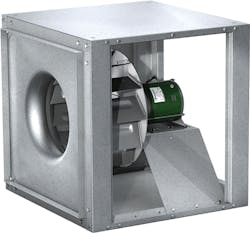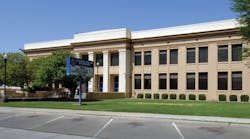Located on the campus of Saddleback Church in Lake Forest, Calif., the Refinery is a two-story, 45,000-sq-ft building that includes dining and kitchen facilities, a theater, game rooms, an 800-seat auditorium, a full-court basketball gymnasium, a half-court practice area, three classrooms, and a multipurpose room for recreation and business meetings.
To save energy, Craig Hofferber of engineering firm H & P Systems Inc. (read his March 2013 HPAC Engineering article “Maximizing Outdoor-Air-Economizer Operation”) wanted to vary ventilation rates based on time of day and room occupancy. The main challenge was finding a cost-effective fan that could run at multiple speeds. Single-phase speed-controlled fans using permanent-split-capacitor motors have limited turndown capabilities and are inefficient at lower speeds. The use of three-phase motors controlled by variable-frequency drives was considered, but deemed cost-prohibitive.
The Solution
The following options were selected by H & P Systems:
• Four direct-drive SQ 160 fans with Vari-Green motors from
• One direct-drive CUE-121-VG fan with Vari-Green motor from Greenheck.
• Five current transducers for sending fan status back to the energy-management system (EMS).
The Vari-Green motors were prewired with control inputs so any controller that can send a 0- to 10-v direct-current (DC) signal can be used to start the fans and adjust their speed from 350 to 1,750 rpm. The fans were connected to direct digital controllers. The controllers interface with the EMS and signal the fans to start and run at minimum speed during off hours and ramp up when an area becomes occupied. The current transducers provide feedback to the EMS for on/off status.
Electrical-room exhaust and audiovisual-room transfer fans are controlled silently with analog 0-to-10-v DC thermostats that monitor room temperature rise. Fans exhausting the restrooms are controlled by the building-management system (BMS) to run at high speed during the day and at a minimum exhaust rate when the building is unoccupied. Relief fans for economizer exhaust vary speed in response to building pressure caused by economizer-system dampers. In this case, common relief fans exhaust excess air from the ceiling plenums in unison according to a single space-pressure controller.
The Results
“The Saddleback staff is extremely happy, and we are happy with these fans as well,” Hofferber said. “We no longer specify belt-driven equipment—unless direct-drive fans are unavailable, and that rarely is the case. The fans we specify are variable-speed with feedback capabilities, so we know what they are doing in every given case.”
All of the fans purchased for the Refinery run maintenance-free and alarm the BMS when a problem develops.
For Design Solutions author guidelines, call Scott Arnold, executive editor, at 216-931-9980, or write to him at [email protected].












